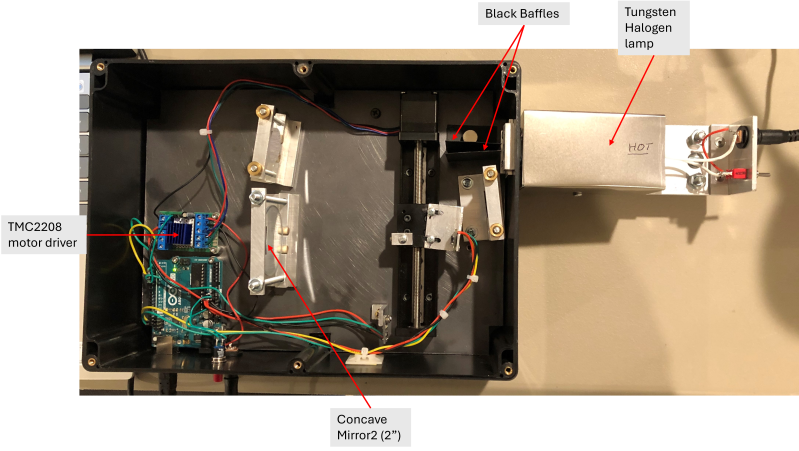Spectroscopy seems simple: split a beam of light into its constituent wavelengths with a prism or diffraction grating, and measure the intensity of each wavelength. The devil is in the details, though, and what looks simple is often much harder to pull of in practice. You’ll find lots of details in [Gary Boyd]’s write-up of his optical scanning spectrometer project, but no devils.
![Schematic diagram of [Gary Boyd]'s spectrometer, showing optical elements and rays of light as well as major physical elements like the motor and linear stage.](https://hackaday.com/wp-content/uploads/2025/04/Screenshot-2025-04-13-at-11-34-30-The-Scanning-Spectrometer-Project.png?w=400)
Specifically, [Gary] has implemented a Czerny-Turner type spectrometer, which is a two-mirror design. The first concave mirror collimates the light coming into the spectrometer from its entrance slit, focusing it on a reflective diffraction grating. The second concave mirror focuses the various rays of light split by the diffraction grating onto the detector.
In this case [Gary] uses a cheap VEML 7700 ambient light sensor mounted to a small linear stage from amazon to achieve a very respectable 1 nm resolution in the range from 360 nm to 980 nm. That’s better than the human eye, so nothing to sneeze at — but [Gary] includes some ideas in his blog post to extend that even further. The whole device is controlled via an Arduino Uno that streams data to [Gary]’s PC.
[Gary] documents everything very well, from his optical mounts to the Arduino code used to drive the stepper motor and take measurements from the VEML 7700 sensor. The LED and laser “turrets” used in calibration are great designs as well. He also shares the spectra this device is capable of capturing– everything from the blackbody of a tungsten lamp used in calibration, to a cuvette of tea, to the sun itself as you can see here. If you have a couple minutes, [Gary]’s full writeup is absolutely worth a read.
This isn’t the first spectrometer we’ve highlighted– you might say we’ve shown a whole spectrum of them.
















“culminates the light” Interesting usage, I suspect it collimates the light though.
Let’s give them the benefit of the doubt with autocorrect. That said, the statement about better than the human eye is a bit odd. Human eyes are really bad spectrometers.
This is a great project though. I wonder how the backlash is on the stepper drive. I hope they upgrade their adc too. Super fun to see old style spectrometers come back to the diy world.
I had hoped to imply that the range of 360 nm to 980 nm was superior to the human eye, given that we conk out around 740 nm. Perhaps my wording could have been better. The human eye is surprisingly good at colour discrimination, though– in ideal conditions IIRC 2 nm resolution has been observed. It’s the intensity response that really ruins any attempt at a naked-eye spectroscope.
Thank you for the benefit of the doubt. I need it. :)
You are awesome don’t worry about it. You are actually putting stuff out there for people to read. And we all know… The internet is a peanut gallery usually visited before people have had their first coffee or after their second has wore off.
Autocorrect strikes again! I think it’s kind of funny though, so I’ll leave it since you’ve already got the errata in the first comment. Good eye.
The Ebert configuration is similar to the Czerny-Turner arrangement except that it uses a single large concave mirror. Adjusting a single mirror may (or may not) be simpler than adjusting two mirrors, I don’t know. Certainly the light-gathering power of a single large mirror is considerably greater than that of the two smaller mirrors.
However…cost. A fast (say f/2) 4″ spherical mirror is likely to be at least an order of magnitude more expensive than the two smaller mirrors Gary used. Possibly much more than that. The game is unlikely to be worth the candle. The mirror. Whatever. ;-)
The fastie Ebert is a great one for semi rugged designs. Sort of an eggs in one basket adventure for a hobbyist. It’s hard to beat a czerny turner generally. Most hobby spectrometers are lens driven so I have to give credit here, seeing a mirror design is refreshing even though the cost is pretty high